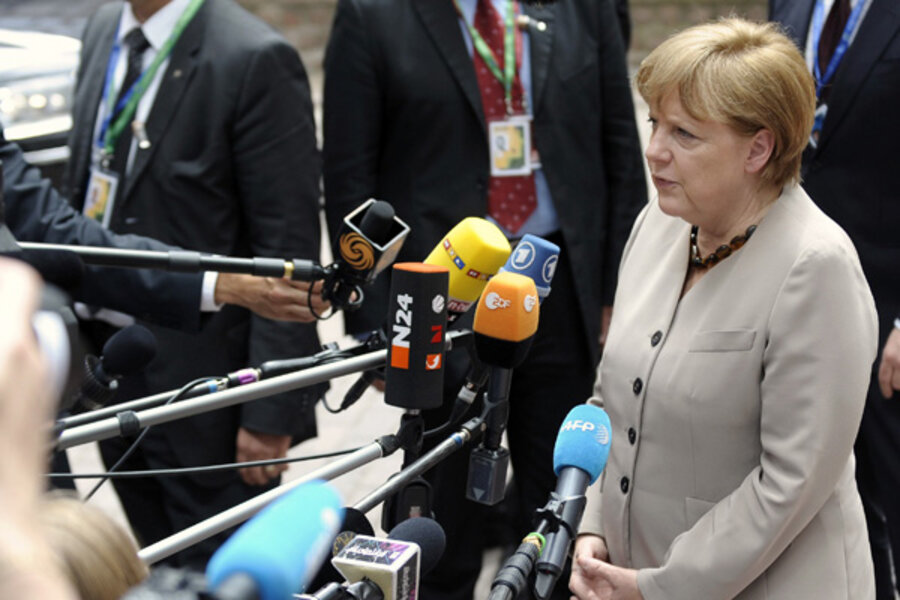Germany vs. Italy: At eurozone meeting, the battle is over urgent action
| Paris
With Italy and Spain in acute crisis, Europe’s leaders convene in Brussels today for a summit that appears heavy on long-term reform, but scarce on short-term measures to quickly staunch the crisis.
Like 19 other summits since 2010, the two-day event is forecast as a “moment” in European history designed to show solidarity, contain the fear of spreading debt, and reassure markets as a crisis that started with Greece now threatens Italy and Spain, the third- and fourth-largest European economies. While expectations of the summit are low, analysts say that the key issue for for markets is the appearance of clear decisions, even if they are designed for the long term.
EU leaders will discuss a new “road map” for closer integration, including establishing a European finance minister, a banking union, shared fiscal sovereignty, and the possibility of allowing Europe's central bank to be a “lender of last resort,” not unlike the Federal Reserve in Washington. The most contested plans are over ceding national fiscal powers to Brussels, and whether to share debt liability and the cost of the crisis across the eurozone.
Germany’s Angela Merkel said this week that she will noy agree to common debt in Europe “as long as I live.”
Italy’s appointed prime minister, Mario Monti, who just passed a crucial labor-law reform, sent a salvo back, saying Europe faces disaster if it can’t stop high debt costs that are sinking his economy and appear to be the result of EU delay and foot-dragging.
Mr. Monti said angry “political forces” in Italy and elsewhere could win the day. Local sentiment, he told reporters in Brussels ahead of the summit, is: “Let European integration, let the euro, let this or that large country" rot.
Italy’s current benchmark 10-year bond costs are 6.3 percent; Spain’s costs are at 7 percent, considered unsustainable.
“The big problem at the meeting in Brussels is Italy,” says François Heisbourg of the Foundation for Strategic Studies in Paris. “Monti is drowning and Brussels and Berlin are not helping him. If Italy goes under, any agreements won’t matter.”
In January, at its most recent “summit to end all summits,” the EU agreed to closer fiscal union; at the same time, the European Central Bank quietly loaned out some $1 trillion to more than 800 European banks in what was seen as “quantitative easing,” EU-style.
But as seen over the past two years, those measures did not sufficiently impress markets. Greece had one failed election in May, and its new government still needs $14 billion to meet expenses and wants to renegotiate its bailout terms.
Markets this spring attacked Spain and Italy just as they did Ireland and Portugal a little more than a year ago.
Yet EU officials have now gone further with a road map for a banking authority, a European finance minister, and to give the European Central Bank more leeway as a “lender of last resort” – all part of a major plan for a more federal Europe advocated in Berlin.
The banking union "elevates responsibility for supervision to the European level, and provides for common mechanisms to resolve banks and guarantee customer deposits," according to a draft of the road map signed by Herman Van Rompuy, president of the European Council.
How much sovereignty France and other European nations would cede to a central fiscal authority is unknown.
The meeting is also expected to agree to a “growth pact” to add $155 billion a year to bailout funds, and leaders will push growth and infrastructure projects.
“I would not dramatize this summit ... because you have seen many European summits these last years,” says Nicolas Véron, senior fellow at Bruegel think tank in Brussels. “On the other hand, the next weeks are very important. You cannot allow yourself the luxury to let the summer go by without deciding anything.”
Chancellor Merkel has the greatest say in Brussels and advocates a “step by step” long term approach seen in the road map.
But unlike at the previous 19 grand summits, she is increasingly isolated and pressed by Italy's Mr. Monti and new French president François Hollande, among others – though it is unclear whether that matters.
Germany’s strategy appears to be to push austerity and long-term reform hard enough to force change, but not so far as to create outright collapse – a delicate task, analysts say, especially since the election of Mr. Hollande.
Merkel yesterday hung tough on a go-slow approach: "Because I know the expectations and hopes that are pinned on this summit, I will repeat …what cannot be said often enough: There is no quick solution and no simple solution. There is no one magic formula ... with which the government debt crisis can be overcome in one go."
While financial advisers at Paris based BNP and in Brussels at Natixis said that short-term solutions in Brussels today are in short supply, the most important is a clearer road map.
“The goal is to make the euro area a more homogeneous and coherent ensemble. What will be interesting is how the results will be presented after the EU summit Friday, and if there is a clear timetable, not only a statement of intent,” says Philippe Waechter, head of economic research at Natixis Asset Management in Brussels. “This is what the markets will pay attention to."
At the recent G-20 meeting in Los Cabos, Mexico, and since, Monti has pushed a plan for the European bailout or “Stability Fund” created in 2010 to be able to buy bank debt directly, in order not to add sovereign debt to national books that sends borrowing costs soaring.
Merkel has so far opposed the Monti concept.





